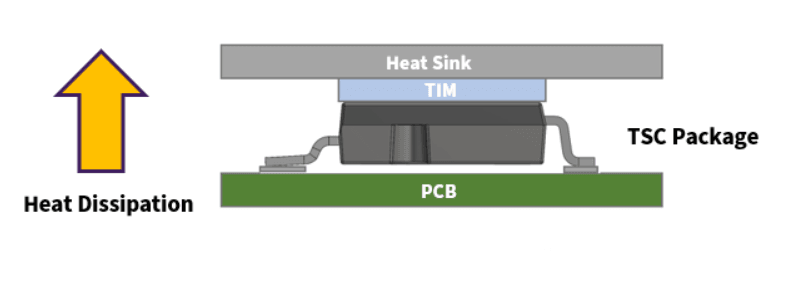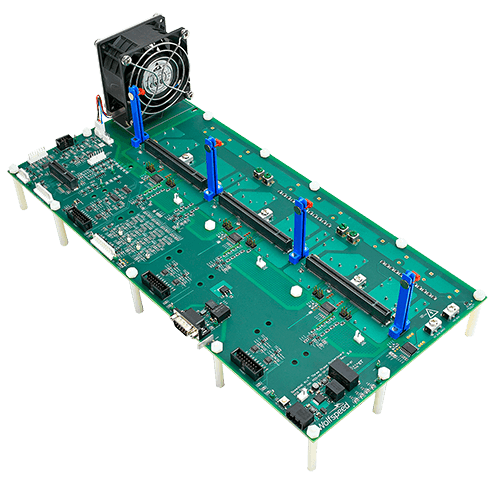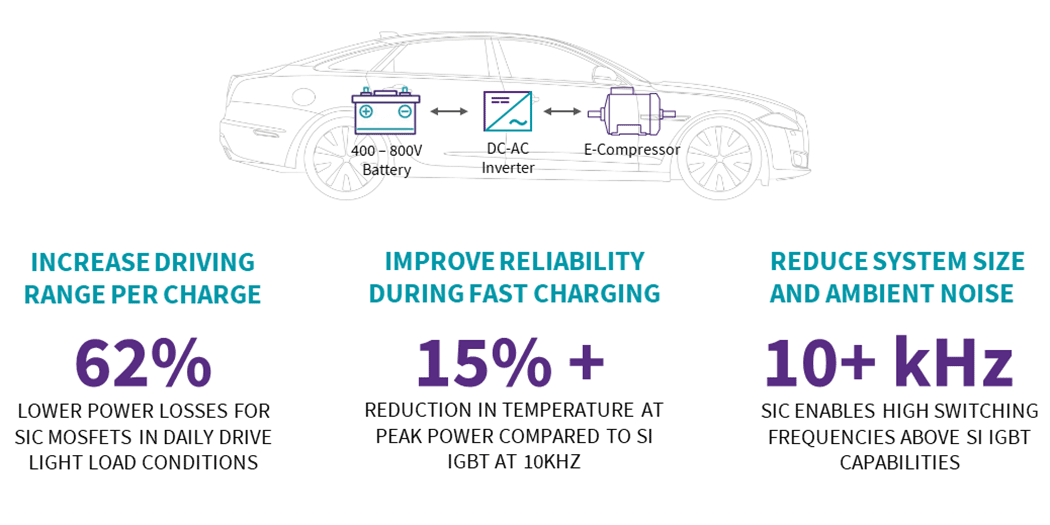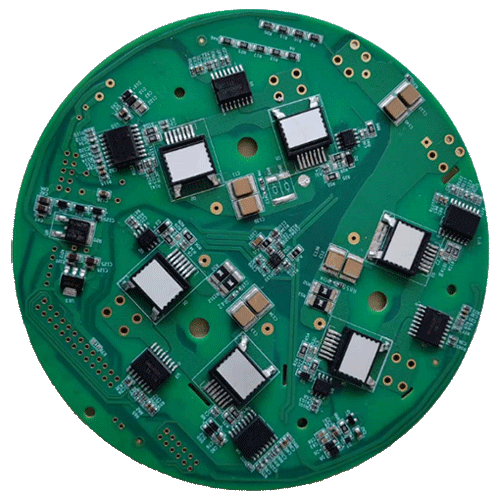-
LATEST NEWS / PRODUCT & TECHNOLOGY / SiC / WBG2 Min Read
SemiQ Inc announced the addition of 1700V SiC Schottky discrete diodes and dual diode packs to its QSiC™ product line. The new devices meet the size and power demands of a wide range of demanding applications including switched-mode power supplies, uninterruptible power supplies (UPS), induction heaters, welding equipment, DC/DC converters, solar inverters and electric vehicle (EV) charging stations.
Featuring zero reverse recovery current and near-zero switching loss, SemiQ’s 1700V SiC Schottky diode technologies offer enhanced thermal management that reduces the need for cooling. As a result, engineers can implement highly efficient, high-performance designs that minimize system heat dissipation, allow the use of smaller heatsinks and lead to cost and space savings. All of the new products support fast switching across operating junction temperatures (Tj) of -55 °C to 175 °C.
The GP3D050B170X (bare die) and GP3D050B170B (TO-247-2L package) discrete diode is rated for respective maximum forward currents of 110A and 151A. Device design supports easy parallel configurations, enhancing flexibility and scalability for various power applications.
The GHXS050B170S-D3 and GHXS100B170S-D3 dual diode packs are rugged modules supplied in a SOT-227 package. Maximum respective forward currents are 110A and 214A and each combine outstanding performance at high-frequencies with low loss and low EMI operation. ensure energy efficiency and reliability by minimizing interference.
Key features include low stray inductance, high junction temperature operation, rugged and easy mounting, and an internally isolated package (AIN), which provides optimal insulation and thermal conductivity. Low junction-to-case thermal resistance enables efficient heat dissipation, ensuring stability under high-power conditions. The modules can be easily connected in parallel due to the positive temperature coefficient (Tc) of the forward voltage (Vf).
“Our new 1700V SiC diodes represent a leap forward in power efficiency and reliability,” said Dr. Timothy Han, President at SemiQ. “With their compact and flexible design, low-loss operation, and superior thermal management, our QSiC™ diodes will enable our customers to create innovative, high-performance solutions while reducing costs and improving overall system efficiency.”
All parts have been tested at voltages exceeding 1870V and have undergone avalanche testing up to 1250mJ. Visitors to SemiQ’s stand at Alfatec’s booth (Hall 7, 418) at PCIM Europe will have the first opportunity to explore the new 1700V SiC diodes.
Original – SemiQ
-
LATEST NEWS / SiC / WBG2 Min Read
Applied EV, a leader in vehicle control system technologies for Software Defined Machines™, announced they have selected CISSOID’s new CXT-ICM3SA series of Silicon Carbide Inverter Control Modules (ICMs) to drive their latest generation of autonomous vehicle E-motors.
Dedicated to the E-mobility market, CISSOID’s software-powered SiC ICMs are augmented with onboard programmable hardware, accelerating the response time to critical events, off-loading the processor cores and enhancing functional safety.
The ICM is integrated into Applied EV’s Digital Backbone™, a centralised control system combining state-of-the-art software and hardware, setting a new benchmark for safety rated vehicles.
Applied EV’s CEO, Julian Broadbent, said “Both Applied EV and CISSOID recognise functional safety is critical in the development and deployment of autonomous vehicles. The partnership integrates CISSOID’s ICMs into our Digital Backbone, allowing for a faster development cycle, giving our customer the safest vehicle in the shortest time possible.”
CISSOID’s CEO, Dave Hutton, said: “We are excited to embark on this collaborative journey with Applied EV to drive innovation in e-mobility. By combining our expertise in electric motor design with Applied EV’s proficiency in software and vehicle integration, the aim is to deliver a game-changing electric motor drive platform for the future of mobility together.”
The collaboration underscores the shared commitment to driving positive change in the automotive industry and contributing to a more sustainable future for transportation globally.
Original – CISSOID
-
Nexperia announced that its class-leading 650 V, 10 A silicon carbide (SiC) Schottky diode is now automotive qualified (PSC1065H-Q) and available in real-two-pin (R2P) DPAK (TO-252-2) packaging, making it suitable for various applications in electric vehicles and other automobiles.
Additionally, in a further extension to its portfolio of SiC diodes, Nexperia is now also offering industrial-grade devices with current ratings of 6 A, 16 A, and 20 A in TO-220-2, TO-247-2, and D2PAK-2 packaging to facilitate greater design flexibility. These diodes address the challenges of demanding high voltage and high current applications including switched-mode power supplies, AC-DC and DC-DC converters, battery-charging infrastructure, motor drives, uninterruptible power supplies as well as photovoltaic inverters for sustainable energy production.
The merged PiN Schottky (MPS) structure of these devices provides additional advantages over similar competing SiC diodes, including outstanding robustness against surge currents. This eliminates the need for additional protection circuitry, thereby significantly reducing system complexity and enabling hardware designers to achieve higher efficiency with smaller form factors in rugged high-power applications. Nexperia’s consistent quality across various semiconductor technologies provides designers with confidence in the reliability of these diodes.
In addition, Nexperia’s ‘thin SiC’ technology delivers a thinner substrate (one-third of its original thickness) which dramatically reduces the thermal resistance from the junction to the back-side metal. This results in lower operating temperature, higher reliability and device lifetime, higher surge current capability, and lower forward voltage drop.
“We’ve seen an excellent market response to the initial release of our SiC diodes. They have proven themselves in design-ins with one notable example in power supplies for industrial applications, where customers have achieved especially good results. The superior reverse recovery of these diodes translates to high efficiency in real-world use”, says Katrin Feurle, Senior Director and Head of Product Group SiC Diodes & FETs at Nexperia. “We are particularly excited that this is our first automotive-qualified product, and it is already recognized by major automotive players for its performance and reliability.”
Original – Nexperia
-
LATEST NEWS / PRODUCT & TECHNOLOGY / SiC / WBG2 Min Read
Semikron Danfoss and SMA announced that the Sunny Boy Smart Energy incorporates the SEMITOP E power modules based on silicon carbide. The SEMITOP E features a low-inductance design with superior thermal performance, all in an industry standard housing. The SEMITOP E product offers a variety of circuit topologies based on the latest 650V-1200V silicon carbide technology from multiple sources.
“We strongly believe that the SEMITOP E is the power semiconductor package of choice for applying silicon carbide in advanced solar inverters,” says Roberto Agostini, Product Manager Semikron Danfoss.
“The SEMITOP E has been essential in increasing throughput and efficiency in our assembly,” says SMA Product Manager Petra Nawratil. “The press-fit design and simple mounting approach enabled a higher automation level in the assembly line for the Sunny Boy Smart Energy and following products.”
Residential solar inverters are tasked with generating solar power with the highest efficiency, enabled through silicon carbide technology.
The Sunny Boy Smart Energy is part of the new SMA Home Storage Solution, which enables fast and effective solar generation and storage. It is scalable to meet changing needs and adaptable to additional use cases such as an EV charger, a heat pump, dynamic tariffs, or peak load shaving. The modular SMA Home Storage battery can be expanded anytime to store more solar power.
Original – Semikron Danfoss



